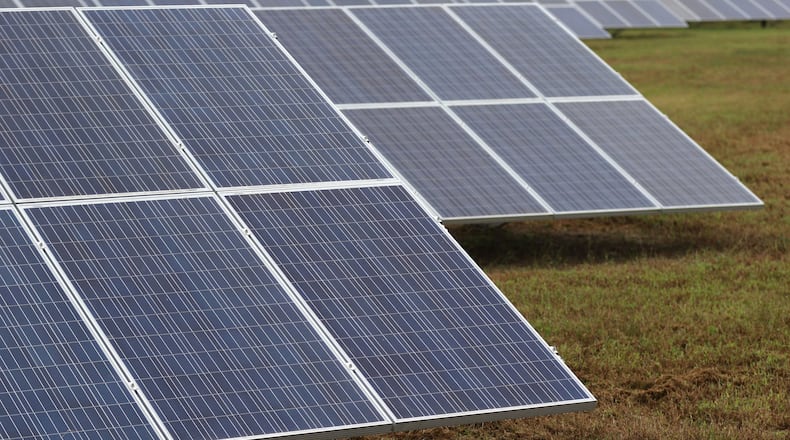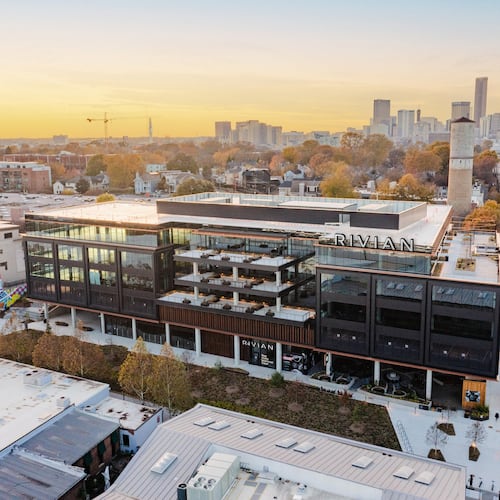Large corporations, led by big tech, are driving much of the solar power development in Georgia and across the country — and challenging utilities to keep up.
Companies like Meta, Amazon and Google are pushing solar development to satisfy their enormous energy needs while reducing emissions and meeting aggressive climate and sustainability goals. The surge in solar has also been driven by steep declines in the cost of panels.
A decade ago, corporate solar demand was dominated by big box retailers investing in rooftop panels. Today, major companies want sprawling off-site solar farms to power or offset the energy needs of massive data centers, offices and factories.
“This is a space that, in the past, only utilities played in,” said Shawn Rumery, senior director of research for the Solar Energy Industries Association (SEIA).
In the South, where a handful of utilities dominate, corporate demand for renewables has also run headlong into grids that need upgrades to transmit power generated by new solar and wind farms. Supply chain issues spurred by the pandemic and trade disputes have also slowed construction.
Georgia, the nation’s eighth-most populous state, is ranked seventh by SEIA for cumulative solar capacity with about 4,500 megawatts. Georgia Power, the state’s largest utility, is the top solar provider.
But Georgia Power has at times struggled to meet market demand for solar and its own renewable energy goals, opening the door for smaller players like Georgia’s network of nonprofit electric cooperatives to win new, large customers.
Unlike Georgia residents and existing businesses, who have to buy electricity from the provider assigned to their area, large commercial or industrial customers building new facilities have a one-time option to choose their utility if their electrical load exceeds 900 kilowatts.
In 2018, Meta, then known as Facebook, chose Walton EMC to power a massive data center in Newton County. Electric vehicle manufacturer Rivian also chose Walton EMC for renewable sources to power its planned $5 billion factory nearby in southern Walton and Morgan counties (The Atlanta Journal-Constitution’s parent company, Cox Enterprises, is a Rivian investor).
Credit: SPECIAL
Credit: SPECIAL
Meta, now the leading corporate solar user in Georgia and nationally, according to SEIA, worked with the co-op and Nashville-based solar developer Silicon Ranch to build seven solar farms totaling 560 megawatts across Georgia. It announced plans this month to double its solar capacity in the Peach State over the next three years.
Meta said in 2020 it had achieved net zero greenhouse gas emissions in its direct operations, such as its data centers and offices, and has pledged to do the same across its entire business by 2030. Urvi Parekh, head of renewable energy at Meta, said access to renewable power plays an important role in where the company chooses to locate new data centers.
“What Walton offered us was exactly what we needed to be able to operate in the state,” she said.
Solar struggles
Inflation, a skilled labor shortage and manufacturing disruption have created additional hurdles for new and unfinished solar projects. After years of panel price declines, prices have increased recently amid heightened demand. Federal trade policy also restricted the supply of Chinese-made panels, something the Democrats’ recent climate and health law seeks to address by incentivizing domestic manufacturing.
On Jan. 11, Qcells announced a $2.5 billion expansion in Georgia that marks the largest investment in solar manufacturing in U.S. history, which in the coming years will help relieve the crunch in domestic panel supplies.
Still, despite challenges, solar accounted for 46% of all new electricity-generating capacity added in the US in 2021 and 45% of all new capacity over the first three quarters of 2022, according to SEIA, and its long-term forecast remains bright.
Credit: Natrice Miller / Natrice.Miller@ajc.com
Credit: Natrice Miller / Natrice.Miller@ajc.com
David Eady, senior manager for industry engagement with the Ray C. Anderson Center for Sustainable Business at Georgia Tech, said companies are responding to the economics of renewable power more than regulation.
“I think utilities are attempting to respond to corporate demand for more renewable power,” Eady said. “As far as whether they are keeping up, I think that’s hard to really measure.”
Delays have been reported across the industry, especially for utility-scale solar projects. Electric Cities of Georgia, the nonprofit that works on behalf of the 52 Georgia cities that resell electricity, has delayed its first major solar project, with Walmart, by a year to 2024, according to ECG President Walter West.
Georgia Power, with 2.7 million customers, is an investor-owned, regulated monopoly overseen by the elected state Public Service Commission (PSC), which must approve its plans to provide electricity to ratepayers every three years.
Prior to the 2022 “integrated resource plan” approved by the PSC this past June, Georgia Power was approved for about 4,747 megawatts of solar, according to the commission. Georgia Power says it has more than half that — 2,600 megawatts — online. The PSC approved an additional 2,300 megawatts of renewable energy as part of the 2022 integrated resource plan.
This spring, Georgia Power announced that 970 megawatts of planned solar installations across the state would be delayed by a year, citing supply chain issues. Then, last month, the company filed paperwork with the state saying a separate request for proposals to build an additional 1,030 megawatts of renewable energy had failed to receive any bids that met its criteria.
“Everybody is having issues with bringing solar online,” said Bentina C. Terry, senior vice president of customer strategy and solutions for Georgia Power.
But Georgia Power has also faced criticism for how it structures its solar programs and its handling of renewable energy credits, the accounting system by which entities can legally claim renewable energy. Some of its solar programs for commercial and industrial customers are at capacity or closed, while others, particularly those that were supposed to encourage the construction of on-site solar arrays, have failed to attract partners.
Some have questioned the commitment of Georgia Power and its corporate parent, Southern Company, to renewables. Jamey Goldin, an energy regulation lawyer at Google, was quoted by the New York Times taking Southern to task over its continued coal-burning, adding that opening the market to competitors would “get a lot more renewable energy online and a lot of that dirty power offline.”
EMCs land big customers
Georgia’s electric membership corporations or cooperatives, or “EMCs,” meanwhile, have notched some of the biggest solar projects.
Largely formed in the 1930s under the New Deal program to bring electricity to rural areas, EMCs serve about 1.9 million members and over 70% of Georgia’s land area.
Green Power EMC, a renewable power company jointly owned by 38 Georgia EMCs, said the co-ops have 975 megawatts of operational solar energy, with roughly double that planned or in construction.
Jeff Pratt, Green Power’s president, helped broker the deal between Meta and Walton EMC.
Credit: Curtis Compton / Curtis.Compton@
Credit: Curtis Compton / Curtis.Compton@
“It was something that had never been done in the state of Georgia, to my knowledge, especially at that scale,” Pratt said. Meta’s solar investment dwarfs that of other customers in the state, and all its projects have been completed on time so far, despite a supply chain and labor crunch, the company said.
Most co-ops serve rural areas, which also happen to be where land is cheap and sunshine plentiful, making them natural local partners for large solar projects. But there are other factors at play as well.
Unlike Georgia Power, which submits its solar plans and programs to the PSC for approval years in advance, cooperatives are able to strike one-off deals to build new projects for specific customers. And, as member-owned nonprofits, the co-ops are also not accountable to shareholders who expect a profit on their investments.
While utilities sometimes compete for large customers, they share a transmission system that will need to be upgraded in order to transmit electricity from solar installations in the sunny south of Georgia to the more populated northern part of the state where demand is concentrated.
“Corporate demand for renewables is already robust and will only grow stronger,” Simon Mahan, executive director of the Southern Renewable Energy Association, wrote in an email. “We need to be better planning the grid for tomorrow ... today.”
This coverage is supported by a partnership with 1Earth Fund, the Kendeda Fund and Journalism Funding Partners. You can learn more and support our climate reporting by donating at ajc.com/donate/climate/
About the Author
Keep Reading
The Latest
Featured





